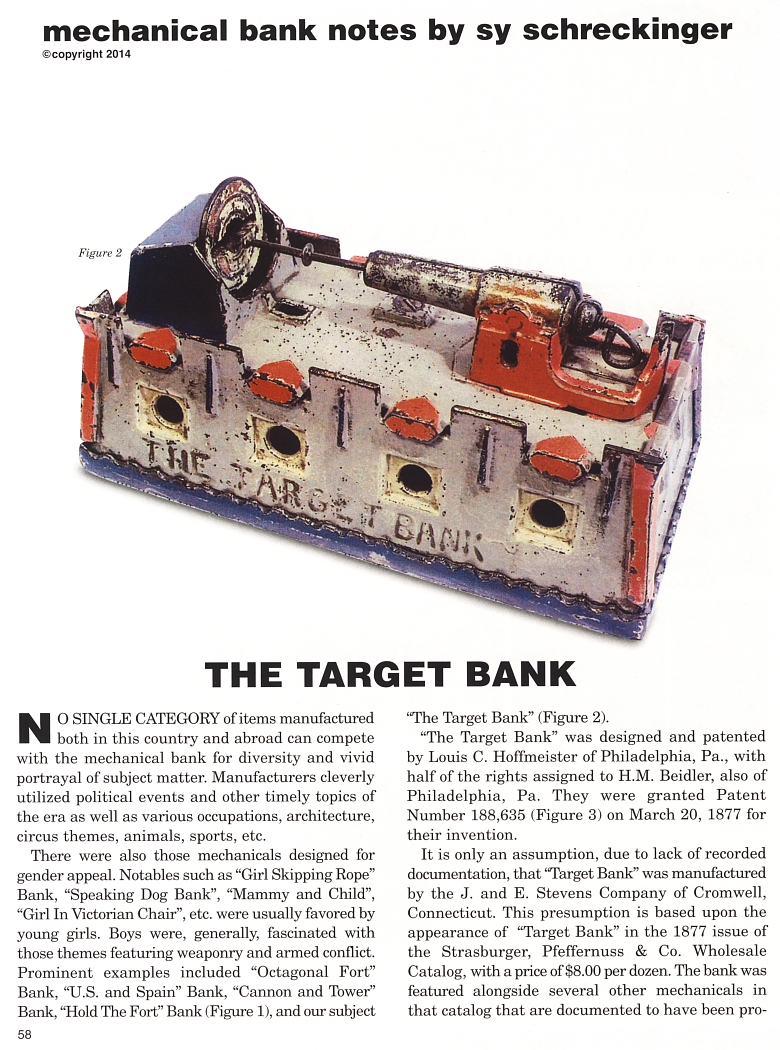|
The Target Bank
by Sy Schreckinger – ANTIQUE TOY WORLD Magazine – September, 2014
NO SINGLE CATEGORY of items manufactured both in this country and abroad
can compete with the mechanical bank for diversity and vivid portrayal
of subject matter. Manufacturers cleverly utilized political events and
other timely topics of the era as well as various occupations,
architecture, circus themes, animals, sports, etc.
There were also those mechanicals designed for gender appeal.
Notables such as "Girl Skipping Rope" Bank, "Speaking Dog Bank", "Mammy
and Child", "Girl In Victorian Chair", etc. were usually favored by
young girls. Boys were, generally, fascinated with those themes
featuring weaponry and armed conflict. Prominent examples included
"Octagonal Fort" Bank, "U.S. and Spain" Bank, "Cannon and Tower" Bank,
"Hold The Fort" Bank (Figure 1), and our subject 'The Target Bank"
(Figure 2).
"The Target Bank" was designed and patented by Louis C. Hoffmeister
of Philadelphia, Pa., with half of the rights assigned to H.M. Beidler,
also of Philadelphia, Pa. They were granted Patent Number
188,635
(Figure 3) on March 20, 1877 for their invention.
It is only an assumption, due to lack of recorded documentation,
that 'Target Bank" was manufactured by the J. and E. Stevens Company of
Cromwell, Connecticut. This presumption is based upon the appearance of
"Target Bank" in the 1877 issue of the Strasburger, Pfeffernuss & Co.
Wholesale Catalog, with a price of $8.00 per dozen. The bank was
featured alongside several other mechanicals in that catalog that are
documented to have been produced by the J. and E. Stevens Company.
Action and operation of "Target Bank" is quite unique. The
mechanical utilizes two coin slots which, as indicated within the
patent, were designed for the admission of both small and large coins.
The design incorporates a circular target featuring a horizontal coin
slot cut through the center of the target (thus intended for small
coins). The patent also indicates a recessed, curved rest, placed
directly in front of a large coin slot located in the base, which is
positioned in front of the target. This rest was designed to enable
large coins to lean against the target itself.
Operation of "Target Bank" is swift and appropriate to the subject.
A thin steel rod which runs through the barrel of the cannon is
initially pulled back and snapped into place. Depending upon its size, a
coin is either inserted horizontally into the target slot or placed
standing against the front of the target. Upon releasing the catch, the
internal rod springs forward, striking either of the coins. The smaller
coin is projected into the "house" behind the target, whereupon it falls
into the body of the Fort. The large coin is pushed sharply against the
face of the target, resulting in its descent through the large slot
located behind the curved coin rest. Deposits are recovered by opening a
screw-secured coin retainer located underneath the base (Figure 4).
Interestingly, during the year within which 'Target Bank" was
patented and manufactured, another "fort-type" mechanical bank was
assigned patent protection and subsequently
produced. This was "Hold The Fort" Bank, seen in Figures 1 and 5. Over
the years, collectors and historians have pondered over the uncanny
similarities of design and action of "Target Bank" and "Hold The Fort"
Bank. Several possibilities were considered. One plausible explanation
was that since J. and E. Stevens presumably manufactured both
mechanicals, perhaps the company consulted with each of the bank's
inventors regarding aspects of design.
"Target Bank" is extremely rare. A mere handful of fine, all
original, complete and working examples are known to populate the
collections of a few fortunate individuals.
I am, at present, not aware of any reproduction of "Target Bank".
Nonetheless, the following are the base dimensions of an original
example: Length: 7-1/4 inches. Width: 3-3/8 inches. If a recast were
attempted, the length would appear approximately one-eighth inch shorter
than indicated.
Acknowledgments: The fine example "Target Bank" (Figure 2) is in
the Kidd Toy Museum Collection, Frank and Joyce Kidd proprietors.
My thanks to the R.S.L. Auction Company for providing the
photograph of "Hold The Fort" Bank seen in Figure 1. |


